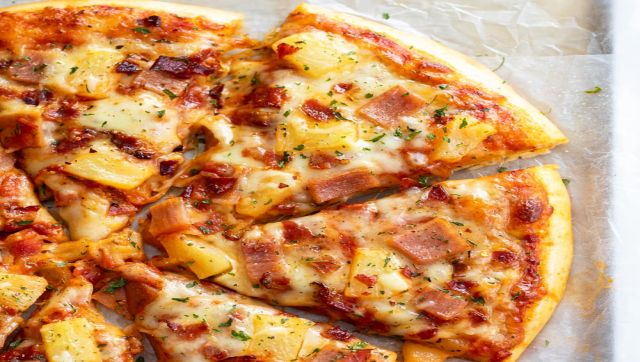Pineapple on Pizza: How the fruit has become the world’s most divisive topping
Pineapple on Pizza: How the fruit has become the world’s most divisive topping

‘Would you eat pineapple on a pizza?’
This could perhaps be the most divisive question in the world. For some, pineapple is an appropriate pizza topping. But for most others, especially in Italy, pineapple on a pizza is blasphemy. Until now.
An Italian chef Gino Sorbillo, also known as Naples’ pizza maestro, has once again drummed up this controversial debate – of the fruit as a pizza topping – by adding ‘ananas’ to his menu in Via dei Tribunali, the best known pizza street in the world capital of pizza.
When asked why, he told CNN that he created it to “combat food prejudice.”
“I’ve noticed in the last few years that lots of people were condemning ingredients or ways of preparing food purely because in the past most people didn’t know them, so I wanted to put these disputed ingredients – that are treated like they’re poison – onto a Neapolitan pizza, making them tasty.”
As the debate heats up again, we take a closer look at how pineapple came to become a pizza topping and the everlasting debate over it.
Origins of Hawaiian pizza
Pizza with pineapple, also known as Hawaiian pizza, has actually nothing to do with Hawaii. The man credited with giving the world this form of pizza is actually a Greek immigrant to Canada, who ran a restaurant with his brothers in the city of Chatham, Ontario.
Food history reveals that in 1962 Sam Panopoulos in his attempt to be different from regular pizza eateries turned to the south for inspiration and found it in pineapple. He placed canned fruit on ham slices on top of the cheese and tomato pizza base and with that a new tasty dish, or culinary crime – depending on which side of the argument you are – was born.

Speaking of his gastronomic invention, in 2017, Panopoulous told the BBC, “We just put it on, just for the fun of it, [to] see how it was going to taste. And why the name Hawaiian? That came from the brand of canned pineapple Panopoulos used.
How did the people react to it? Panopoulous said that they liked it. “Because those days, nobody was mixing sweets and sours and all that. It was plain, plain food.”
To hate or to love pineapple on pizza
Initially, the Hawaiian pizza gained love from people and soon pizza eateries across the world started featuring them on their menus. But today, Hawaiian pizza is also maybe the most hated food in the world.
In fact, some joke that the world is divided into two types of pizza; the ones who drool over pineapple on their pizza and the others who find it repulsive and inedible.
In fact, in 2017 a survey had revealed that 54 per cent of people said that pineapple had no place on a pizza. Another survey carried out in 2022 in the US also found that pineapple was among the most detested toppings, with a whopping 32 per cent, only preceded by anchovies (35 per cent).
In Italy, most would say that pineapple on pizza is a complete no no.
Also read: Cheesed off! What happened when Domino’s tried to sell pizzas to Italians?
The former president of Iceland Guðni Th Jóhannesson had also waged into the debate in 2017 when he said during a Q&A session that he hates pineapple on pizza so much that he would ban it if he could pass laws on his own.

Following his remarks, Jóhannesson had to issue a statement on his Facebook page, saying, “I like pineapples, just not on pizza. I do not have the power to make laws which forbid people to put pineapples on their pizza. I am glad that I do not hold such power. Presidents should not have unlimited power. I would not want to hold this position if I could pass laws forbidding that which I don´t like. I would not want to live in such a country. For pizzas, I recommend seafood.”
And it wasn’t just the Icelandic prime minister. Noted chef Gordon Ramsay has also expressed his disdain for pineapples on pizza. He has been quoted as saying, ““You don’t put f***ing pineapple on pizza.”
Pineapple does not go on top of pizza….. https://t.co/lhD6aliOV8
— Gordon Ramsay (@GordonRamsay) April 4, 2017
Even our very own Ranveer Singh is not a fan of pineapples on pizza and joins other celebrities such as Harry Styles, Jessica Chastain, Eddie Redmayne, and Jimmy Kimmel.
But for every naysayer, there is one lover of pineapple on pizza. Canada’s Justin Trudeau, Parineeti Chopra, Paris Hilton, Justin Bieber, Tom Holland, Jeff Goldblum, and Dwayne Johnson are all fans of the fruit on their pizza.
I have a pineapple. I have a pizza. And I stand behind this delicious Southwestern Ontario creation. #TeamPineapple @Canada
— Justin Trudeau (@JustinTrudeau) February 24, 2017
Hating on pineapple
But why is it that a few chunks of fruit on a pizza have become such a widely divisive issue? One of the primary reasons for it is that most people think of pizza as a savoury dish and are horrified by the idea of putting anything sweet on it.
There’s also genetics at play. Scientists have found that a person’s liking for sweet tastes is influenced by their genes. As Zhimin Xu, a food scientist at Louisiana State University Agricultural Center in Baton Rouge, US, told the BBC, “There are many chemical reactions when pineapple is being heated, as it contains a lot of sugars and organic acids.”
And cooking pineapple at very high temperatures, as is in pizzas, changes the structure and taste of the pineapple, making some people love it and others detesting it.

There also chefs who believe that pineapple and tomatoes shouldn’t mix as they are both acidic in nature. The acidity may become overwhelming when combining the two, giving you an upset stomach.
Some also argue that the pairing of pineapple with cheese is a culinary disaster.
However, there are chefs who argue that those who say pineapple isn’t an acceptable pizza topping because it doesn’t taste good, they probably haven’t had it done right. “Raw chunks of pineapple thrown around a pizza? No way. Roasted and pulled pineapple with a honey glaze paired with a fatty pork is delicious. No need for tomato on that pineapple pizza, there’s enough acid to go around,” one was quoted as telling The Independent.
So, which side are you on this debate?
With inputs from agencies
